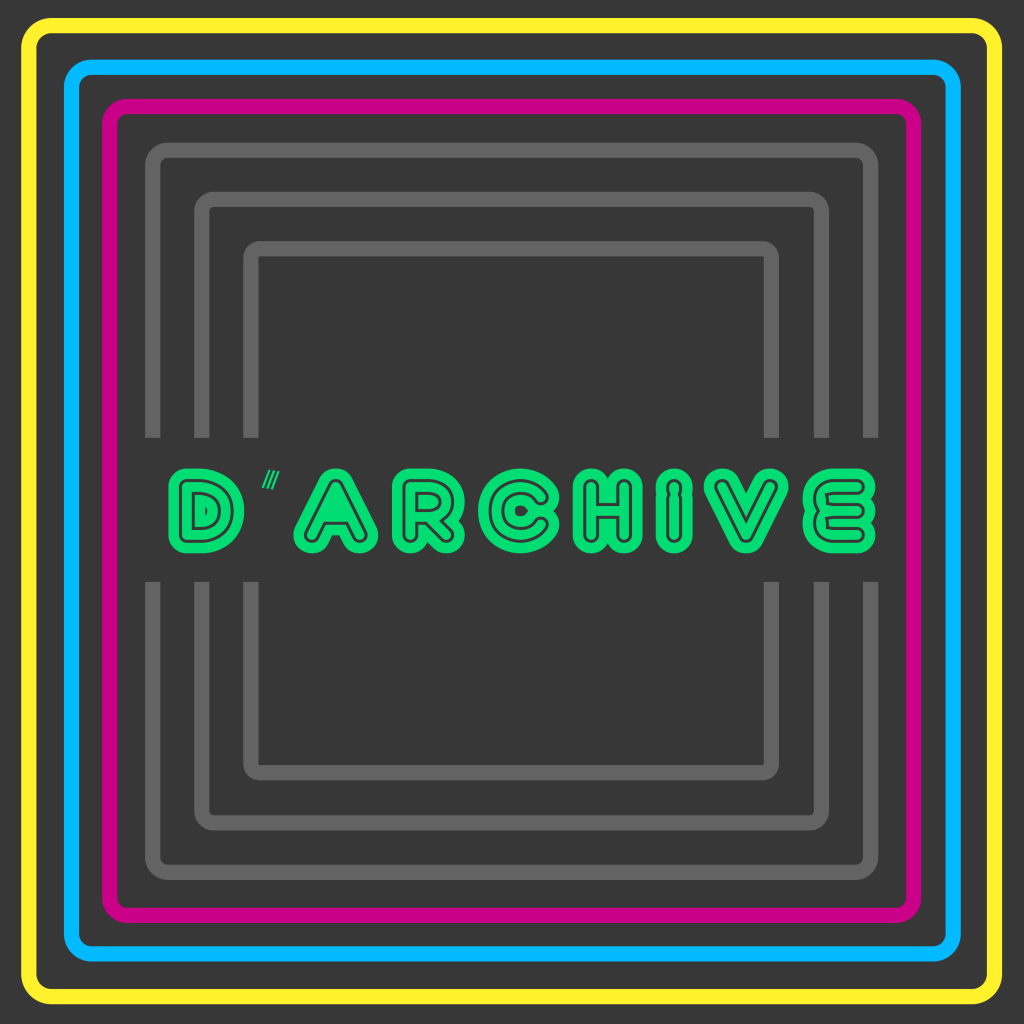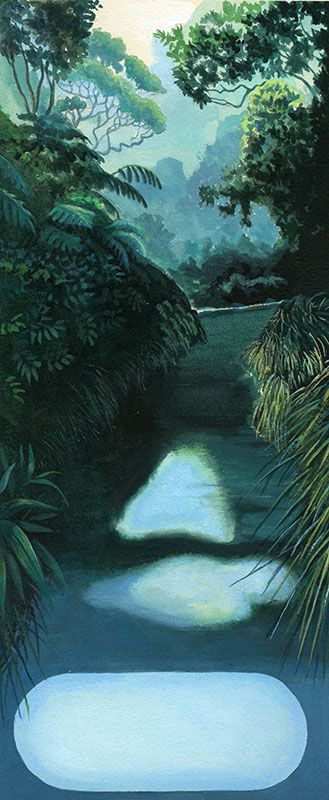The UConn Archives & Special Collections podcast d’Archive will release it’s 50th episode on April 24th, 2023 with a live broadcast at 10am EST on 91.7fm WHUS. Beginning in August of 2017, the Archives staff began expanding its outreach program to the airwaves by training on sound engineering and radio protocols in order to effectively bring its collections to new audiences. Since then the radio program and podcast has featured weekly episodes drawing from countless collections held by the Archives & Special Collections and amplifying the expertise of over 60 collaborators ranging from past and present archives and library staff, artists, journalists, curators, faculty, graduate and undergraduate students, high school students, visiting fellows and international students, activists, alumni, collectors and donors, family, and friends.
Continue readingEncounters with the Natural World: Work by Margaret Waring Buck, Katherine Shelley Orr and Jean Day Zallinger
The artists and scientists presented in this exhibition began observing their natural surroundings at a young age. One is the daughter of a draftsman, one a trained portrait painter, one a self-described “doodler and daydreamer” who loved the sea. Either formally or informally, all have used art to communicate through visual representation what they systematically observed. Each shared their observations in non-fiction books for children in the hope of instilling a strong desire to learn and a curiosity about the world.
On view are paintings, drawings, sketches and notes answering the question “what do I see around me?” These artists responded to what the author of The Beginning Naturalist, Gale Lawrence, encouraged her readers to do, “begin to look at what’s around you, ask yourself questions about what you see, and find answers. Only in this way will you establish a meaningful and lasting relationship with the natural world – of which you, too, are an important part.”
This exhibition is being shown to complement Raid the Archive: Edwin Way Teale and New Works on view at the William Benton Museum of Art, University of Connecticut, from January 17 to March 10, 2023.
UConn Archives & Special Collections
Richard H. Schimmelpfeng Gallery
January 31, 2023 – April 21, 2023
The Many Faces of Vivien Kellems, 1896 – 1975
[slideshow_deploy id=’9789′]
Archives & Special Collections announces the opening of a new exhibition, “The Many Faces of Vivien Kellems,” featuring the life and achievements of the inventor, activist, businesswoman, political candidate, and philanthropist, Vivien Kellems. The exhibition marks the completion of a multi-year project to digitize the Kellems Papers; generously funded by Suzy Kellems Dominik over the past several years.
Vivien Kellems was born 7 June 1896 in Des Moines, Iowa, to David Clinton and Louisa Flint Kellems. Shortly after her birth, her parents, both Christian Ministers, moved their family to the west coast and settled in Eugene, Oregon. The only girl of a family with seven children, Vivien developed a rugged and competitive personality from an early age. Attending the University of Oregon, she made her mark as the only female on the debate team. Vivien Kellems obtained a bachelor’s degree in 1918 and a master’s degree in economics shortly thereafter. After graduation, she moved to New York City pursuing a doctorate from Columbia University and then, nearer the end of her life, University of Edinburgh.
While she resided in New York, her older brother, Edgar E. Kellems, invented a significant improvement to an existing cable grip, which he patented in the late 1920s. With the patent as a foundation, Ms. Kellems founded Kellems Cable Grips, Inc. in 1927, moving the new company to Stonington, Connecticut. In the early years, the company’s devices were used most notably during the construction of the Chrysler Building, George Washington Bridge, and later played a vital role in production of wire and artillery shell grips used during World War II. Her thirty-year tenure as president of the Kellems Company brought many challenges, travel, and opportunities for expansion. For example, during WWII, Kellems’ business interests and travels converged with her personal life—bringing unwanted attention and controversy. Vivien’s connections and subsequent relationship with Count Frederic von Zedlitz, a German national from a prestigious family, was scrutinized by the U.S. Congress because of her “love letters” to a “Nazi agent.”
In addition to her business interests, Vivien Kellems was actively engaged in various struggles for justice as she fought for women’s equality, equal suffrage along party lines, and tax reform. As a member of the Liberty Belles, Vivien led by example as the group encouraged equality of women in the home, workplace, and society. Running as an independent candidate for U. S. Senate, Ms. Kellems protested strict party line voting that only required a single lever pull rather than voting individually for a preferred candidate. She made several bids for United States Senate, for the Connecticut Governorship in 1954, and, in 1964, led the Barry Goldwater Presidential Campaign in Connecticut.
Vivien Kellems practiced active civil disobedience to support her positions on state and government practices, particularly those of taxation and party voting. She famously sat in a voting booth for nine hours straight before fainting from exhaustion in her protest of the party lever. With her degree in economics, unfair taxation by the government was a frequent and long fought battle. In 1948, alongside her business partner and brother David Kellems, she protested the “requirement” of withholding taxes from her employees’ checks claiming, “if they wanted me to be their (tax) agent, they’d have to pay me, and I want a badge.” A lengthy court battle ensued, during which it was determined that the Kellems Company would go bankrupt if taxes were not withheld and paid. Admitting defeat on this issue, Kellems turned her focus to the inequality of taxes paid by single individuals compared to married couples. The income tax law enacted after World War II required unmarried citizens to pay twice the amount of income tax than did those citizens of equal earnings who were married. In protest, from 1965 until her death, Vivien Kellems would send in blank tax forms with her signature. Coming close to victory many times in the United States Supreme Court during the first half of the 1970s, Ms. Kellems’ fight in this case came to naught. She died before her final appeal was heard in 1975. On this issue, she traveled the country speaking at numerous events and appearing on television to highlight the cause of the singles income tax. She amassed a nationwide fanbase who wrote to her extensively in support and admiration for her campaign against unfair taxation.
Vivien Kellems left a vibrant legacy, documented in an impressive collection of photographs, business records, legal and tax documents, political ephemera, and memorabilia that is available for research and study in the University of Connecticut’s Archives & Special Collections. Come and explore the story of a trailblazing firebrand who faced great odds but refused to back down.
The exhibit is scheduled to run through 13 January 2023 and features highlights from Vivien Kellems storied life, focusing on her activist causes, business achievements, and political aspirations. The installation of exhibit documenting the life of this remarkable woman is also in commemoration of the 50th anniversary of the University of Connecticut Women’s Center.
The Famous Ghost Train of the New York and New England Railroad
[slideshow_deploy id=’9758′]
On March 16, 1891, the opulent White Train, a luxury passenger train of the New York and New England Railroad, pulled out of Summer Street station in Boston on its first run, set to arrive in Grand Central Station in New York City in six hours. The Boston Herald reported that people lined the route through the city and suburbs “and gazed with mingled curiosity and delight at its handsome appearance.”
The train was pure Gilded Age splendor – its parlor cars were fitted with velvet carpets, silk draperies, and white silk curtains. The chairs were upholstered in gold plush; full-length glass mirrors were installed at each end of the cars. The coaches were heated with steam piped directly from the locomotive, an improvement over the fat-bellied stoves used in ordinary coaches. Pintsch gas lights brightly illuminated the coaches, replacing oil burning lights normally in use.
The dining car’s menu included baked striped bass with Italian sauce, roasted spring lamb, ribs of beef, sauté of chicken with mushrooms, and a wide array of vegetables, salads and desserts, with every fine wine and liquor available. There is no question that this luxury train was meant to serve the exquisite tastes of the robber barons and financial kings of the time.
The White Train’s name was literal – all of the cars were painted white. On its first run the crew, which included the famous locomotive engineer Gene Potter, wore white coats or overalls, white caps and white gloves. As time passed, when the white cars traveled through the countryside, particularly at dusk or in the evening, observers came to refer to it as an “eerie apparition.” Thus the White Train was soon better known as the Ghost Train.
In 19th century America, the railroad train held a place of prominence as the fastest mode of transportation. As the century progressed and more railroad lines were formed throughout the country, the railroad companies competed on which could produce the fastest trains. Prior to the 1880s travel between the financial centers of New York City and Boston usually involved steamships along Long Island Sound, connecting with trains in New London, Connecticut, or Fall River, Massachusetts. It wasn’t until 1893, when the New York, New Haven & Hartford Railroad completed its Shore Line Route, that passengers could ride uninterrupted between the two cities.
The New York and New England Railroad (NY&NE) was one of several inland routes, running from Boston to the Hudson River. Despite promoting itself as the “Air Line Route,” a reference to a route that cut through Connecticut and central Massachusetts on a diagonal, giving the impression it was faster than the Shore Line routes, it had to contend with the region’s many grades, curves and lightly constructed bridges. That did not deter the NY&NE’s goal of dominating passenger service between New York City and Boston.
The NY&NE debuted its first high-speed train along the Air Line Route in November 1884. Named the New England Limited, it was initially successful but by the late 1880s began to lose ridership to the New York, New Haven & Hartford Railroad’s Shore Line trains, which included the The Gilt Edge and the Shore Line Flyer.
In an effort to bring back customers to its inland route the NY&NE transitioned the New England Limited into the White Train, which was touted as the height of luxurious travel. The White Train was actually two trains, each leaving New York or Boston at 3 p.m., arriving at the other city at 9 p.m.
When leaving from Boston the train traveled 86 miles through central Massachusetts into Connecticut, on a right-of-way owned by the NY&NE, with no stops until it arrived in Willimantic, where it changed engines. The train then went on to Middletown and New Haven, completing its journey into Grand Central on right-of-way owned by the NYNH&HRR.
The NY&NE found the cost of keeping the white cars clean to be exorbitant, and the Ghost Train lasted just four and a half years. Its last run was on October 20, 1895, and was succeeded by the Air Line Limited. That same year the NY&NE was taken over by the New York, New Haven & Hartford Railroad. The Air Line Limited ran until 1902, and passenger service ended on the old Air Line route by 1937.
The Ghost Train lives on in legend as one of the Gilded Age’s most opulent and noteworthy trains. This poem was distributed to its passengers on its first run in 1891, and well describes its impact at the time.
List, oh list to the railroad bard, Our new “White Train’s” the latest card; List to the poets’ dulcet rhyme, This train is always in on time!
Spread the glad news wide and fast The White Train’s come to Town at last! Such beautiful cars have never been seen, Outshining in splendor the sun’s bright sheen.
Without a jar, or roll, or antic, Without a stop to Willimantic, The New England’s Limited takes its way, At three o’clock each and every day.
One half the glories have not been told, Of that wonderful train of white and gold, Which leaves every day for New York at three, Over the scenic NY & NE!
Special thanks to historian Richard A. Fleischer for his help in clarifying the many confusions involving 19th century New England railroads, editing this writing and providing research and photographic materials.
Celebrate American Archives Month with Archives & Special Collections at an Open House on October 12, 2022
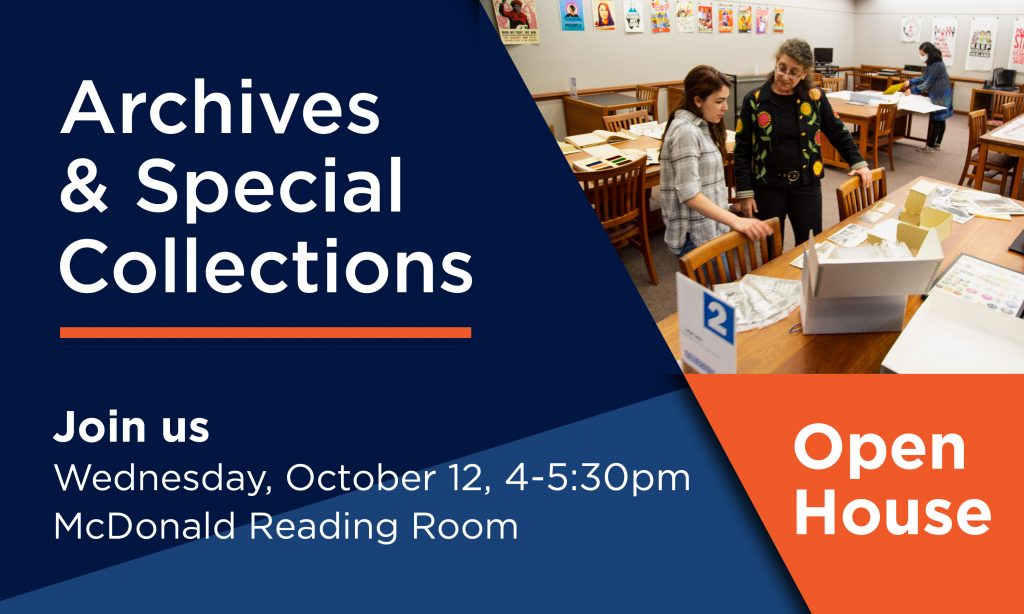
Dodd Center for Human Rights from 4:00-5:30pm
Join us for a curated celebration of American Archives Month, behind-the-scenes tours, zine-making, giveaways, refreshments, and more!
Free and open to the public. All are welcome.
American Archives Month gives archives around the nation the opportunity to highlight the importance of records of enduring value. At UConn Archives we believe that archives reveal by enabling people to examine and better understand the past, that archives inspire by being useful for many purposes, and that archives are for everyone!
This is also the closing event for the exhibition Days and Nights of Prints and Punk in the Schimmelpfeng Gallery, providing your last chance to see the evolution of the punk rock scene over 4 decades.
October 12 is also #AskAnArchivist Day.
Archivists around the country will take to Twitter to answer your questions about any and all things archives. This day-long event, sponsored by the Society of American Archivists, will give you the opportunity to connect directly with archivists in your community—and around the country—to ask questions, get information, or just satisfy your curiosity. No question is too silly . . .
#AskAnArchivist Day is open to everyone—all you need is a Twitter account. To participate, just tweet a question and include the hashtag #AskAnArchivist in your tweet. Your question will be seen instantly by archivists around the country who are standing by to respond directly to you. Have a question for a specific archives or archivist? Include their Twitter handle with your question.
Activism at the High School Level
Over the past six months, I have had the privilege of working to digitize the Alternative Press Collection (APC) here at the University of Connecticut Archives and Special Collections. While the APC contains publications created by all kinds of people that discuss all kinds of topics, a large portion of the collection focuses on activist movements during the 1960’s and 1970’s. I began working to digitize files from the APC after I graduated from UConn and have thus looked at a lot of different materials dealing with many different forms of activism.
When studying the history of activism in the United States, a lot of sources will focus on the groups and movements that were either created by or largely consisted of young adults, particularly those in college. This is hardly surprising, given that college communities are most often structured in a way that encourages students to spend substantial amounts of time together and discuss current events, which often leads to like-minded individuals coming together over specific topics. College students also have easier access to resources such as printing which makes spreading awareness easier than it otherwise would be. When all these things are put together, they create a recipe for large activist groups that can leave behind tangible evidence of their activities and their beliefs.
One branch of activism that is less frequently discussed, however, is high school activism. This is, again, not unexpected. High school students have access to fewer resources than their college-level counterparts and are often subject to more restrictions around where and when they’re able to assemble. But teenagers across the country have always been a part of activist movements. Within the Alternative Press Collection here at the UConn Archives and Special Collections, there are several different publications created by High School activists who had hoped to give students access to points of view other than what they might get from their parents and teachers, and to spread awareness of movements and events that they might not otherwise hear about.
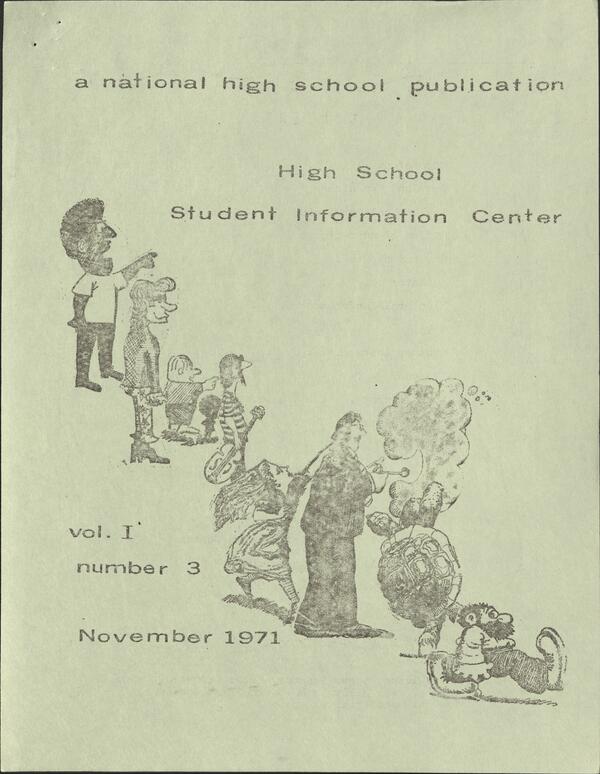
The different publications come from across the country and cover topics ranging from nationwide movements all the way down to local issues, from an investigation into the legal rights of American high school students to a discussion about an income tax versus a sales tax in Windsor, Connecticut. Some of these publications also claim that the administration at their schools have explicitly forbidden them from writing and publishing these articles, yet they have decided to do so anyway, despite the possible consequences. In an issue of ‘The Brick; A Really Heavy Paper,’ for example, an anonymous contributor describes the pushback this publication received from school boards and administrators in various schools in Nassau County, New York.
“In one school, (we cannot mention its name in print) the Brick has been forced underground. Having been refused permission by the principal and distribution off campus is impossible we must do it in school. Our aim is to reach the students and we will do whatever is necessary to achieve this.”
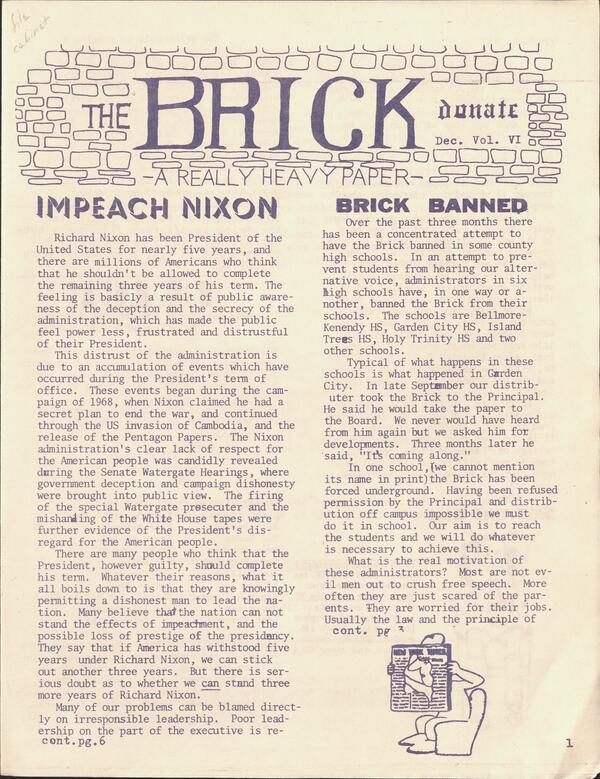
Publications like The Brick serve as important reminders that activism has no age limit. To see more examples of High School activist publications, follow this link to the Alternative Press Collection High School Publications folder.
Finding Primary Sources Online
With so many primary sources available online researchers don’t necessarily have to travel to an archives to find what they need. Academic and cultural heritage institutions have spent the last many years scanning large swaths of their collections and making them available in digital repositories, or have highlighted their collections in online exhibitions. Given the vast amount of primary sources held in the institutions’ physical spaces the resources that are available online are often just a drop in the bucket, but for many researchers the materials now available online have been as helpful as if they had made the trek to the research institution.
These databases are some of the best we know to provide primary sources to any researcher:
How to find archival materials in the UConn Archives:
The UConn Library digital repository holds holds scanned items from the archives. Note that while there are over 1,000,000 scanned items from the UConn Archives this represents only a small percentage of our overall collections: http://hdl.handle.net/11134/20002:UniversityofConnecticut
Information about all of our collections, some of which may be digitized but most of which are not in the digital repository: https://archivessearch.lib.uconn.edu/
The UConn Library’s catalog, which provides information about published sources in the UConn collection but also leads to primary sources, at https://primo-pmtna01.hosted.exlibrisgroup.com/primo-explore/search?vid=01UCT&lang=en_US
If you’re not finding what you’re looking for from the UConn Archives please contact us directly, at archives@uconn.edu, to discuss your research with our staff.
How to find sources in other archives in Connecticut:
The Connecticut Digital Archive has digital collections from dozens of cultural heritage institutions in the state (including the UConn Library), at https://ctdigitalarchive.org/
Connecticut Archives Online is a searchable database of the finding aids to collections in the state, at https://archives-library.wcsu.edu/cao/search/
Connecticuthistory.org, at https://connecticuthistory.org/, provides stories on Connecticut topics, often illustrated with archival sources.
Connecticut History Illustrated, http://connecticuthistoryillustrated.org/
Connecticut State Library Digital Collections, http://cslib.cdmhost.com/index.php
Yale digital collections, http://web.library.yale.edu/digital-collections and http://web.library.yale.edu/digital-collections/all
How to find finding aids and research guides, with information about collections in the United States:
ArchiveGrid, which provides access to over 5 million finding aids of collections across the United States and internationally, https://researchworks.oclc.org/archivegrid/
Online Archive of California, https://oac.cdlib.org/
How to find archival collections at archives in the United States:
The Digital Public Library of America provides access to digital collection across the United States, https://dp.la/. It also provides themed primary source sets and online exhibits at http://dp.la/primary-source-sets and http://dp.la/exhibitions. If there is any one source to go to for comprehensive information about digital collections this is it!
National Archives catalog, http://www.archives.gov/research/catalog/, their resources for students and teachers, DocsTeach.org, and their online research tools: https://www.archives.gov/education/history-day/online.html
Smithsonian Institution, at https://library.si.edu/collections
The Library of Congress digital collections, at https://www.loc.gov/collections/ and their digital newspapers, at http://chroniclingamerica.loc.gov/
Digital Commonwealth, which provides access to digital collections in Massachusetts, https://www.digitalcommonwealth.org/
Calispere, of the University of California system, https://calisphere.org/
New York Public Library, https://digitalcollections.nypl.org/
New-York Historical Society, http://digitalcollections.nyhistory.org/
Avalon, http://avalon.law.yale.edu/ provides access to documents in law, history and diplomacy from ancient times to the present
The UConn Library has a guide to eResources available primary to members of the UConn community, https://blogs.lib.uconn.edu/news/new-eresources-at-the-uconn-library/
Published historical resources, which can often be used as primary sources:
HathiTrust— https://www.hathitrust.org/ — provides access to millions of historical books and journals online
Google books, https://books.google.com/
Research guides to help you get the most from primary sources:
Primary and Secondary Sources Overview, https://guides.lib.uconn.edu/primary
What is a Primary Source?, https://guides.lib.uconn.edu/primary_source
Latin American & Caribbean Studies Guide – Primary Sources, https://guides.lib.uconn.edu/lacarib/primarysources
Top 10 Tips for Navigating Archival Research
[slideshow_deploy id=’9702′]
The process of conducting archival research can be daunting and seem confusing, especially for those who are new to working in an archive. UConn Archives & Special Collections wants to help demystify the research process by providing you with our top 10 tips for doing archival research, which should help with increasing research efficiency and productivity during your visit.
Here are some strategies and suggestions for working in the archives from our experienced team of staff and student workers. From planning your visit, to navigating the archive, to processing your research when you are home, we hope that this information will help guide you on your research journey, wherever you may be.
For more information on researching from home, check out this post!
Days and Nights of Print and Punk
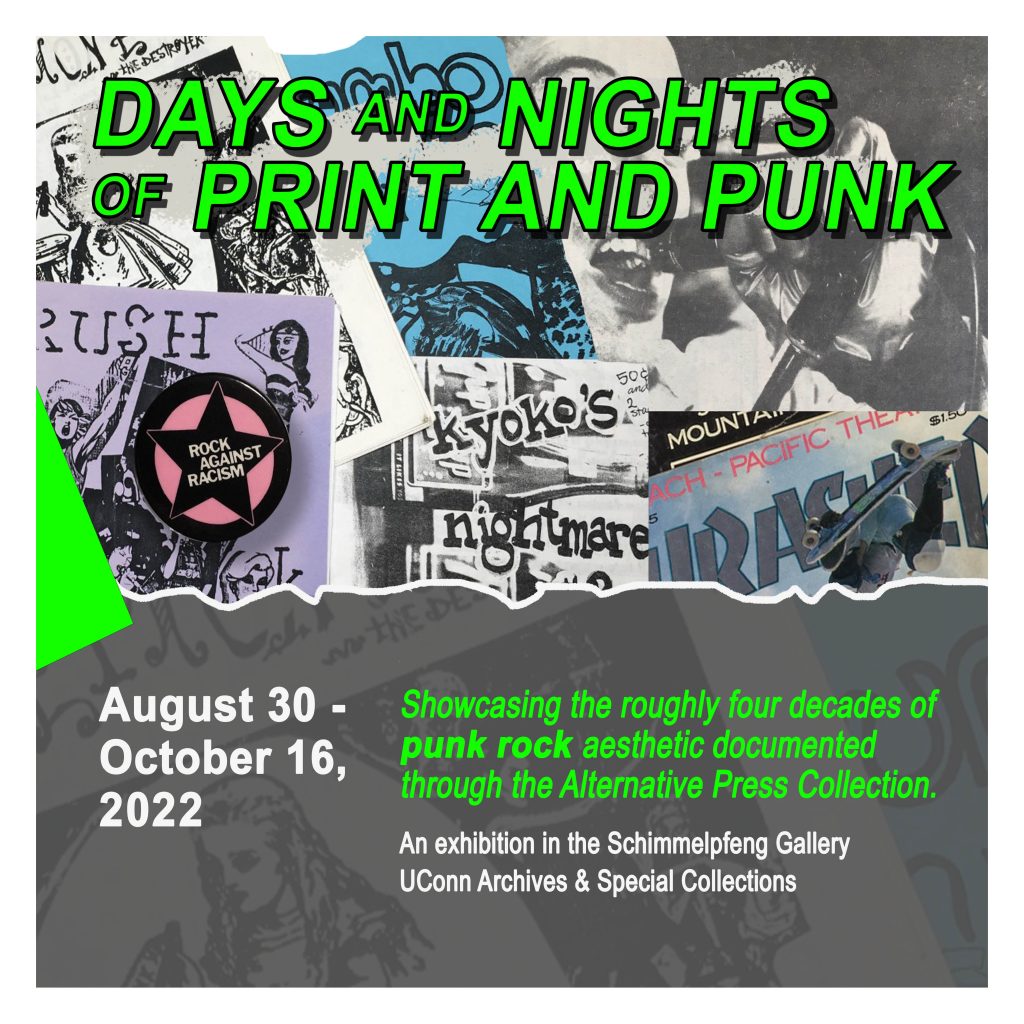
Exhibition on view August 30 – October 16, 2022
Monday through Friday, 9:00 a.m. to 4:00 p.m
Schimmelpfeng Gallery, UConn Archives & Special Collections
Virtual Zine Workshop September 29, 12:30-1:30pm
Closing Event & Archives Open House October 12th, 4 – 6 pm.
The UConn Archives & Special Collections presents Days and Nights of Print and Punk, showcasing the roughly four decades of punk rock aesthetic documented through the Alternative Press Collection. From the 1970s punk rock of bad attitudes and discontent in England and the U.S., seeds were sown to propagate a unified front of thumbed noses to the status quo. Those same attitudes of youth rebellion were reinterpreted from problems into solutions by each successive generation drawing from positive mental attitude, feminism, DIY socioeconomics, animal rights, and anti-racism. Through show flyers, riot grrrl and skate zines, t-shirts, stickers, vinyl, cassettes, and posters, the evolution of the scene has demonstrated its adaptability for youth movements from the late 1970s to the present day. This exhibition also features selections of performance photographs from the traveling exhibition Live at The Anthrax from the Joe Snow Punk Rock Collection. Joe photographed the thriving Connecticut Hardcore Punk (CTHC) scene in the late 1980s during the final years of The Anthrax club in Norwalk, CT (’86-’90). Shot on 35mm black and white Kodak film, these images represent historical documents that bring the viewer as close to the action as possible, providing an intimacy into this subcultural space from 35 years ago. The photographs were selected and reprinted with the intent to highlight the primacy of analog at that time as well as the aesthetics of the not-so-distant past illuminated by a sweat tinted flash bulb.
This exhibition is drawn from the following archival collections:
Andrews Punk Rock Collection, Fly Zine Collection, Kauffman Zine Collection, King Alternative Press Collection, Noelke-Olson Button Collection, and Snow Punk Rock Collection.
This exhibition is programmed in conjunction with the William Benton Museum of Art exhibition Wild Youth: Punk and New Wave from the 1970s and 1980s running concurrently.
D-I-Y Zine Basics September 29, 12:30-1:30pm via Zoom
Zines are DIY publications that have served as modes of expression as well as communication for underrepresented subcultures and social movements, including punk. They are analog and use a collage aesthetic to combine image and text in visually engaging ways. In this virtual workshop, learn about DIY publications with Archivist Graham Stinnett and Metadata Librarian Rhonda Kauffman to get started making your own zines. Held in conjunction with the exhibitions, Days and Nights of Print and Punk at UConn Archives’ Schimmelpfeng Gallery and Wild Youth: Punk and New Wave from the 1970s and 1980s at the William Benton Museum of Art.
Suggested materials list: • 1 sheet of letter sized paper • Magazines, newspapers, stickers to collage with, preferably images with high contrast. • Glue stick or tape • Sharpie fine and ultra fine permanent markers • 1-inch and ¾ inch alphabet stickers in various colors • Patterned Washi tape
Level Up materials list: • Label maker • Plastic bone folder • Alphabet stamps w/ink pad • Long arm stapler • Typewriter • Photocopier
Resources in the Archives Related to Reproductive Rights and Abortion
[slideshow_deploy id=’9662′]
In light of the June 24, 2022, United States Supreme Court decision in Dobbs v. Jackson Women’s Health Organization, which overruled previous decisions Roe v. Wade (1973) and Planned Parenthood v. Casey (1992), Archives & Special Collections here provides a list of materials related to reproductive rights and abortion that are held in our collections.
The landmark decision in Roe in 1973 stated that “the Due Process Clause of the Fourteenth Amendment to the U.S. Constitution provides a fundamental “right to privacy” that protects a pregnant woman’s liberty to abort her fetus,” while the 1992 decision in Casey modified Roe by holding that requiring spousal awareness in order to get an abortion put undue burden on married people seeking abortions.
As of the 2022 decision in Dobbs, abortion is no longer a constitutionally guaranteed right in the United States, leaving the decision to individual states.
For those conducting research projects about reproductive rights, abortion, or related topics, Archives & Special Collections holds resources related to the topic in various media, both from pro-choice and anti-abortion perspectives. These materials range from polling information, correspondence, political documents, organizational literature, and much more. Among some of our archives’ relevant items are:
Connecticut Women’s Educational and Legal Fund Records. Connecticut Women’s Educational and Legal Fund (CWEALF) was founded in 1973. Related to reproductive rights, one major point in the collection is the Pregnancy Rights Project/Program, which took place in the 1980s, but CWEALF continues its work in advocacy, education, and empowerment to this day. Within the collection are publications, press releases from the organization, various writings, educational texts, administrative files, and more. Alongside reproductive advocacy, the records also include information on work CWEALF has done for LGBTQIA+ people. For more information on how to navigate this collection, a finding aid can be found online here: Connecticut Women’s Educational and Legal Fund Records
National Organization for Women, Connecticut and Rhode Island Chapters Records. Founded in 1966, the National Organization for Women is a feminist organization, with currently around 500,000 members. The organization advocates for women’s rights across many fronts, including reproductive health. This collection includes informational literature, meeting minutes, newspaper clippings, and more from both the Connecticut and Rhode Island chapters of NOW. For more information on how to navigate this collection, finding aids can be found online here: National Organization for Women, Connecticut Chapter Records and National Organization for Women, Rhode Island Chapter Records
Connecticut Civil Liberties Union Records. The CCLU was founded in 1949 as the New Haven Civil Liberties Council, and is now the Connecticut affiliate of the American Civil Liberties Union (it currently goes by the name ACLU of CT). This collection includes records from the original NHCLC, as well as administrative records from the CCLU from 1958-90. On the subject of reproductive rights, the collection includes legal documents from two cases: Women’s Health Services v. Maher (1979-1981) and Doe v. Maher (1981-90). Both deal specifically with Connecticut law surrounding abortion. For more information on how to navigate this collection, a finding aid can be found online here: Connecticut Civil Liberties Union Records
Alternative Press Collection Files. The Alternative Press Collection consists of publications created by various people, groups, and organizations. There are many items in the collection that cover the topics of reproductive rights and abortion, both in digitized online form and solely in the physical stacks. Below are a few links that will help to navigate the collection.
APC File Inventory – This link goes to a list of all the publications within the APC Files, both digitized and physical.
Abortion Rights Movement of Women’s Liberation Advertisement – This link goes to an advertisement for ARM’s (Abortion Rights Movement) services to aid women in receiving, specifically late term abortions. Also includes a letter from Sandra Sullaway, Los Angeles coordinator of ARM (February 23, 1979).
Archives Batch Search for “APC Abortion” – This link goes to a search result on the UConn Library website that includes 22 results for items in the APC Files related to abortion.
Public Official’s Records. The following list are each their own collections, consisting of papers belonging to political officials, with each collection including text related to reproductive rights or abortion. For more information on how to navigate these collections, finding aids can be found online at the links with each name.
Audrey Beck Papers – Audrey P. Beck (1931-1983) was a Connecticut politician and professor. She served in the Connecticut House of Representatives from 1967 to 1975, followed by a term in the Connecticut Senate from 1975 until her death in 1983. Prior to her political career, Beck taught Economics at the University of Connecticut.
Barbara B. Kennelly Papers – Barbara B. Kennelly (born 1936) is a former U.S. Representative from Connecticut’s 1st District, where she served from 1982 to 1999. Prior to this, she served as Connecticut Secretary of State from 1979 until 1982.
Chase Going Woodhouse Papers – Chase G. Woodhouse (1890-1984) was a U.S. Representative from Connecticut’s 2nd District, where she served two terms, from 1945 to 1947 and then from 1949 to 1951. Prior to this, she served as Secretary of State of Connecticut from 1941 to 1943.
Nancy L. Johnson Papers – Nancy L. Johnson (born 1935) is a former U.S. Representative, where she served both Connecticut’s 6th District from 1983 to 2003 and its 5th District from 2003 to 2007. From 1995 to 1997, she chaired the House Ethics Committee. She served in the Connecticut Senate from 1977 to 1983.
Prescott S. Bush Papers – Prescott S. Bush (1895-1972) was a U.S. Senator from Connecticut, serving from 1952 to 1963.
Robert N. Giaimo Papers – Robert N. Giaimo (1919-2006) was a U.S. Representative from Connecticut’s 3rd District, where he served from 1959 to 1981.
Robert R. Simmons Papers – Robert R. Simmons (1943-) is a former U.S. Representative from Connecticut’s 2nd District, serving from 2001 to 2007. He served in the Connecticut House from 1991 to 2001, and after he left office he served as First Selectman of Stonington, Connecticut from 2015 until 2019.
Sam Gejdenson Papers – Sam Gejdenson (1948-) is a former U.S. Representative from Connecticut’s 2nd District, where he served from 1981 to 2001. He served in the Connecticut House of Representatives from 1975 to 1979.
Stewart B. McKinney Papers – Stewart B. McKinney (1931-1987) was a U.S. Representative from Connecticut’s 4th District, where he served from 1971 until his death in 1987. He served in the Connecticut House of Representatives from 1967 to 1971.
William R. Cotter Papers – William R. Cotter (1926-1981) was a U.S. Representative from Connecticut’s 1st District, where he served from 1971 until his death in 1981.
Connecticut State Labor Council, AFL-CIO Records. This collection consists of the records of the Connecticut branch of the AFL-CIO, the United States’ largest labor union federation. Relating to the issues of reproductive rights and abortion, one item that the collection has is a group of letters from people commenting on whether or not the union should take a pro-choice stance. This debate took place in the early 1990s, and since then, the AFL-CIO currently is a pro-choice organization. For more information on how to navigate this collection, a finding aid can be found online here: Connecticut State Labor Council, AFL-CIO Records
American Association of University Women, Connecticut Division Records. Founded in the 1880s by Marion Talbot, a graduate of Boston University, and Ellen Swallow Richards, an MIT graduate, what began as the Association of Collegiate Alumnae has been supporting women who have graduated from college ever since. This collection includes information on the organization’s history, programs it has run, legal activity, information on specific branches within Connecticut, and more. Information on what the AAUW has done regarding reproductive rights can be found mostly in the legislative information section. For more information on how to navigate this collection, a finding aid can be found online here: American Association of University Women, Connecticut Division Records
Laurie S. Wiseberg and Harry Scoble Human Rights Internet Collection. The Human Rights Internet consists of materials related to human rights organizations from across the world, including newspapers, reports, NGO literature, books, journals, correspondence, and more. The collection began in 1977, with Drs. Laurie Wiseberg and Harry Scobie as its founders. It includes human rights documents in many languages, including “English, French, Spanish, Dutch, German, Swedish, Chinese and Japanese (among many others),” according to the finding aid. Within the collection are materials belonging to Human Rights Watch, the International Council on Human Rights Policy, Amnesty International, and Anti-Slavery International. For more information on how to navigate this collection, a finding aid can be found online here: Laurie S. Wiseberg and Harry Scoble Human Rights Internet Collection
Connecticut Citizens Action Group Records. Founded in the early 1970s by Ralph Nader and Toby Moffett, CCAG states that its goal is to empower citizens of Connecticut in their roles as “consumers, workers, tax payers, and voters.” Information on reproductive rights may be found within the “Health Project” series of the collection, as well as in Director Marc Caplan’s files. For more information on how to navigate this collection, a finding aid can be found online here: Connecticut Citizens Action Group Records
Samuel Lubell Papers. Samuel Lubell (1911-1987) a journalist and public opinion pollster. This collection includes notes, manuscripts, correspondence, and reports belonging to Lubell. One portion of this collection that is relevant to reproductive rights is public opinion polling he did of students in the 1960s, with abortion being one of the topics polled about. More broadly, he also worked on studies related to women’s issues in the 1940s and 1950s. For more information on how to navigate this collection, a finding aid can be found online here: Samuel Lubell Papers
Stephen Thornton Papers. Stephen Thornton (born 1951) is a community organizer in Connecticut. Since his days at UConn organizing student protests of the Vietnam War, Thornton has been advocating for various causes, with groups such as the Peoples Bicentennial Commission, the Anti-Racist Coalition of Connecticut, and more. This collection includes newspapers, alternative press, flyers, correspondence, notes, writings, and other forms of paraphernalia. Within the collection are some items related to reproductive rights. For more information on how to navigate this collection, a finding aid can be found online here: Stephen Thornton Papers
This post was written by Sam Zelin, formerly a UConn undergraduate student in the Neag School of Education who was a student assistant in Archives & Special Collections.
Library Reflections: Cameran Kershner ’22
This reflection was written by Cameran Kershner ’22, who joined the UConn Library as a student employee in the Collections Strategy department and as an intern in Archives & Special Collections. Cameran will pursue graduate work in library and information science at the University of Tennessee Knoxville’s School of Information Sciences this fall.
In pursuance of my future career goals, this year I decided to seek out work experience in UConn’s very own Homer Babbidge Library as well as an internship in the Archives & Special Collections. At Homer Babbidge, I was hired as a collections assistant where most of my work was done with the Hathi Trust. The primary goal of the partnership was to take physical copies of books that we have here in the library and compare them page by page to the matching online scans in the Hathi Trust database. While it might seem like tedious work, the point of this job being done is to assure researchers and students that they are able to have the best quality materials available to them. As for my internship, I spent months pulling materials stored in our Archives to compile a research guide filled with sources about the Civil Rights Movement and the student activism surrounding this issue.
Both experiences have familiarized me with the inner workings of library and archive systems such as how to read the categorization classifications for pulling materials and how to conduct thorough research. Since I primarily did most of my work individually, I have also learned how to manage myself as well as grow confident in my ability to problem solve. One of the most important skills I believe I learned was how to communicate effectively. In my internship I was constantly scheduling meetings to track my progress and reaching out to other professionals to ask for research suggestions. This taught me just how integral communication is to run a library efficiently.
My interest in Library Sciences came about accidentally, as I was just doing a bit of research into the qualifications needed for law librarianship. Once I began to read into what it consisted of and just how many avenues could be opened to me by pursuing this degree, I grew quite passionate about it. The specific area that I hope to focus on is academic and public librarianship, as I feel strongly about working with people as much as possible. I think this is what I like best about both of my experiences – the ability it has to help people. I was able to provide scholars and students alike with the means to learn all while making it easier for them to do so. Knowledge is power, and the knowledge gained from accessing these resources could lead to new research discoveries and breakthroughs that help us understand the world around us better.
What makes the world of library sciences so special to me is that no matter what profession you choose within its sphere, you are giving people access to unlimited information. We can use the materials the archives and libraries provide us to learn about the past, supply context to the present, and change the future.
Poetry in Translation in the Little Magazines Collection
A project by Nicole Catarino, UConn English Department Writing Intern, Spring 2022. Background by Melissa Watterworth Batt, Archivist
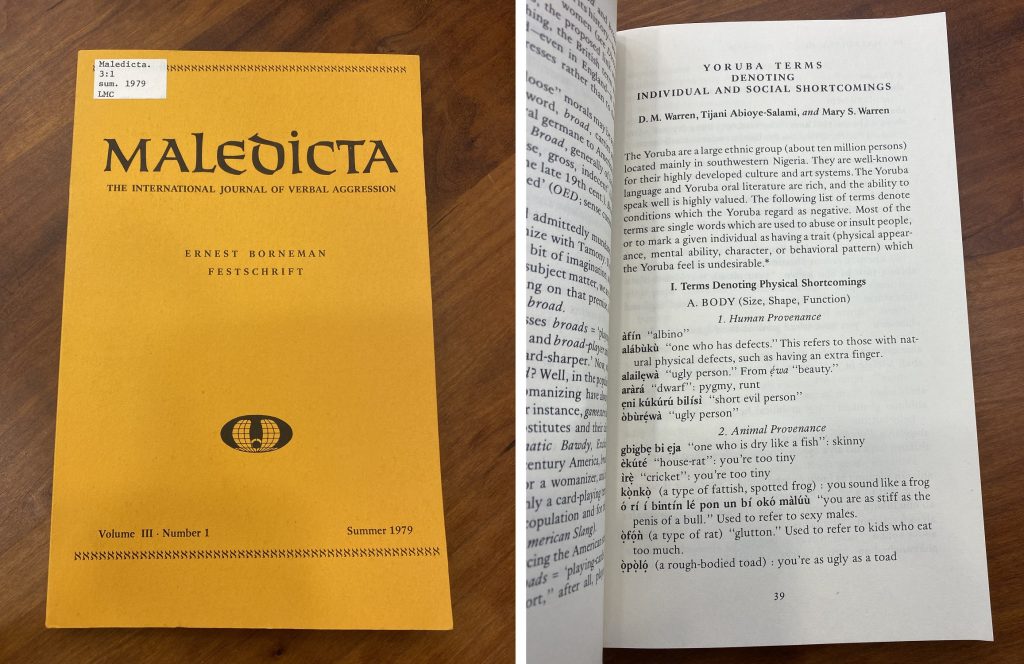
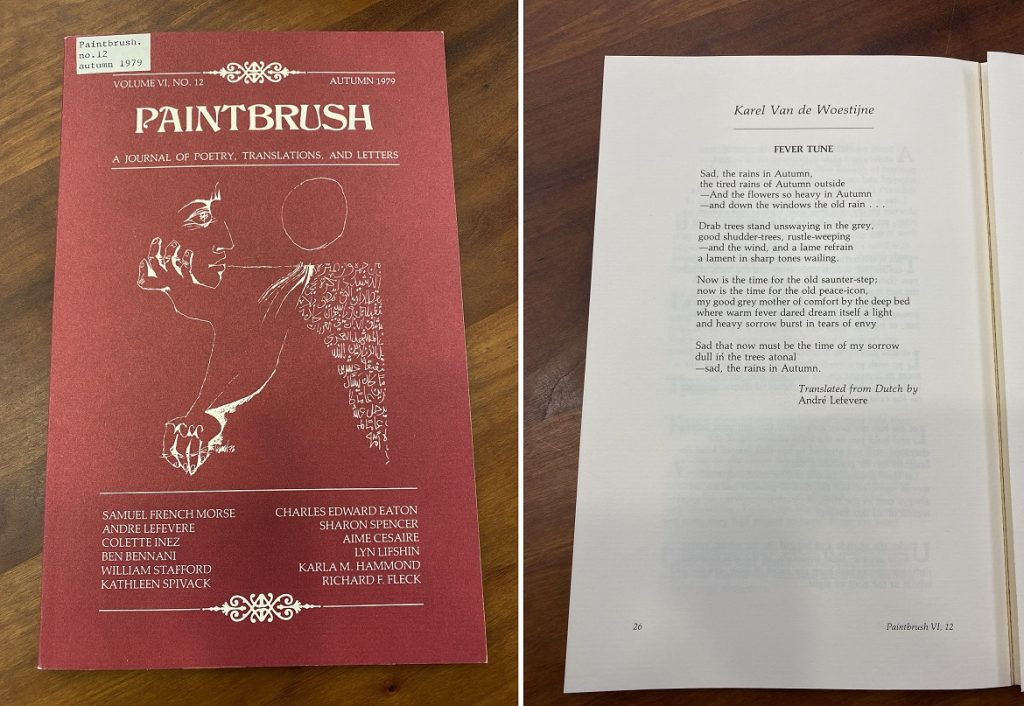
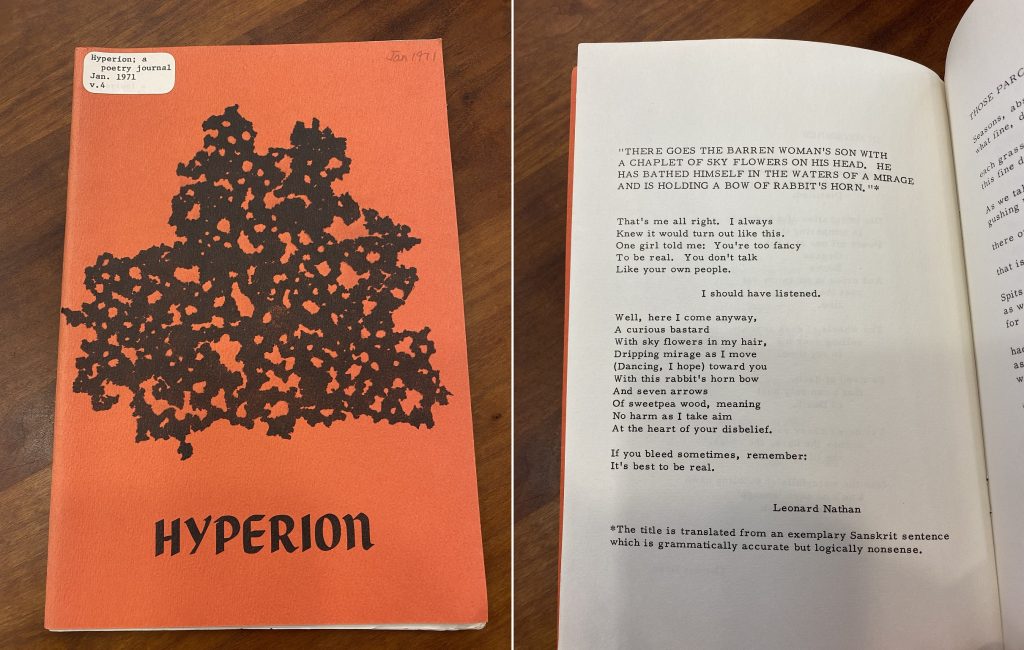
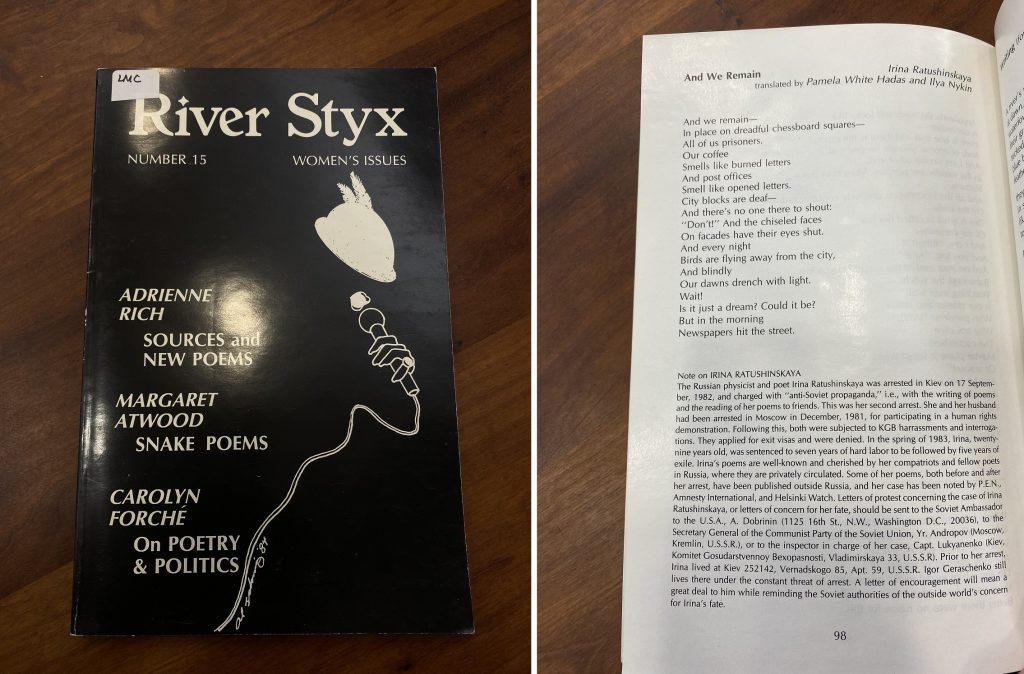
Project Background
Literary periodicals of the 1900s exerted a strong influence on the poetics and shifting literary trends of the twentieth century. Many of these periodicals were edited by writers themselves and deliberately circulated outside, or on the margins, of popular media.
With the introduction of the personal computer and new offset printing technology in the 1970s, independent presses, often short-lived and with small budgets, thrived. Non-profit publishing organizations of the period assisted with distribution, providing grants to establish presses and distribution networks internationally.
Ironically, small print runs, while less profitable, enabled independent presses to stay afloat during the economic turmoil of the 1980s when many corporate, commercial publishing companies cancelled or suspended operations in the literary marketplace. By the mid-1980s, a diversifying publishing industry offered new writers, including non-English language writers, expanded opportunities for publication.
Bibliography
My name is Nicole Catarino, an English major and literary translations minor here at the University of Connecticut, graduating with the Class of 2022, and for the length of the Spring 2022 semester, I have been an intern at UConn’s Archives and Special Collections Department working with Archivist Melissa Watterworth Batt. My internship project revolved around the Archive’s collection of little magazines and the published translations one can find in these literary journals.
“Little magazines” are defined as periodicals produced with small budgets and a limited team, and experienced small print runs and limited distribution. These publications were often short-lived. Today, the Little Magazine collection here at UConn is comprised of over 700 titles from the 1920s to the 2000s, representing a wide array of writers and writing styles, experimental works, graphic novels, zines, and artists books.
However, despite the Little Magazine Collection’s diverse grouping of literary journals and other periodicals, Archivist Watterworth Batt and I realized that very little research had been conducted for the genre of literary translations. That’s when we arrived at the initial idea for my internship project. My goal was to create a cohesive bibliography of little magazines in the collection that published translated works in their journals.
We decided to set our focus on the little magazines that were founded or running in the 1980s because that was the era in which publication started to become cheaper and more accessible. As a result, independent writers and editors began to create journals that stepped away from the themes and content of mainstream publications and instead focused on experimental styles, forms, and genres while also providing a space for new and emerging writers. Archivist Watterworth Batt and I agreed that if there was ever a time for translations to become more popular in the world of little magazines, it would be the 1980’s.
Ultimately, the reason why I chose to focus on literary translations, of all genres, was for two purposes. One was because as a student minoring in literary translations, I knew that a detailed bibliography about where to find translation-focused literary journals would be a fantastic resource for both students and professors alike. My second reason, however, stemmed from my own love for translations and my frustration that this genre of literature is frequently not given the same credit and valor as other literary genres. Translations are complicated and elegant facets of literature that allow us to share cultural stories, folklore, and perspectives on the human experience that otherwise would go unnoticed or unheard due to the language barrier. For this reason, I wanted to highlight these kinds of creative works and find how many resources there are for this genre of literature here at UConn.
The bibliography I created for this project contains six main categories in the spreadsheet: the title of the little magazine that published the translation, the original language the piece was written in, the writer who wrote the original piece, the translator who wrote the translation, the volume and number of the corresponding issue and when it was published, and then any other interesting writers of note or extra information about the journal that I may have discovered. The purpose of this last section was to emphasize just how important little magazines are for writers by listing many famous authors and poets who got their start by publishing in little magazines—like Margaret Atwood, Joyce Carol Oates, and Adrienne Rich, among others.
My hope is that, aside from providing a useful resource to translators and researchers, this bibliography will help stir more interest in the Archives’ magnificent collection of little magazines, so if you have the chance to browse the collection, I highly encourage you to do so!


